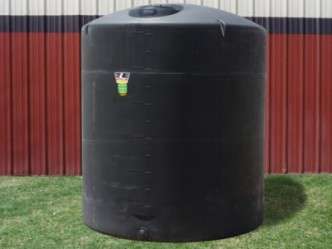Long-Term Water Storage (LTWS) is almost identical to Short-Term water storage except for 3 unique distinctions:
- LTWS should be treated as a replenishment source.
- LTWS should be preferably be stored in bulky containers rather than Short-Term Water Storage.
- LTWS should be strategically placed and accessible, more so than your Short-Term.
 LTWS should be treated as a replenishment source
LTWS should be treated as a replenishment source
Long-Term water storage is potentially the crowning jewel of your preparations. Seriously. Many people are overwhelmed with the false perception that establishing their LTWS is expensive and daunting. Some even have second-thoughts before actually carrying through with it. Truth be told? It's one of the easiest and most essential aspects of Real Life Insurance. The most difficult part is probably deciding where exactly to place it.
Your LTWS should be viewed as the primary source from which you will replenish portable and easily refillable containers. The bulk storage tank(s) will serve to keep a safe and manageable supply of water on-hand for a recommended period of 91+ Days.
LTWS should be preferably be stored in bulky containers rather than Short-Term Water Storage
Your Short-Term water storage is unique in that it can be easily stored in several areas because the quantities are smaller than your Long-Term provisions. When we talk about bulk containers, this can be adjusted relative to your CCP, but I generally refer to bulk as an amount more than you can comfortably and practically transport.
The fact that you have a larger quantity of water stored requires that you make sure it is properly maintained and the integrity of the water remains uncompromised. Because of the density of water in bulk containers, it requires extreme temperature exposure over a sustained period of time to affect the water (freezing & evaporation). However, it is still best to use an opaque-colored container to limit the sun's rays from heating any air inside of the container, promoting evaporation. The opacity also inhibits potential contamination from growths like algae, because of their process of photosynthesis. If your storage is going to be placed within a structure that is dark, use of a safe translucent container would work ideally, making the visibility of the water level and quality easier to handle.
 One additional aspect of bulk containers is their potential for withstanding additional weight, such as drywall, a shelving or cabinet unit, or other items that might knock against the container or land on top of it. This can happen with ground movement from an earthquake or structural damage from a tornado or hurricane. The characteristic that you would be interested in, in this regard, is called compression testing. You can often find out what the compression testing is from the manufacturer or distributor of the HDPE containers or other bulk storage units. Compression testing or a compression rating, simply refers the ability of that object to withstand compression.
One additional aspect of bulk containers is their potential for withstanding additional weight, such as drywall, a shelving or cabinet unit, or other items that might knock against the container or land on top of it. This can happen with ground movement from an earthquake or structural damage from a tornado or hurricane. The characteristic that you would be interested in, in this regard, is called compression testing. You can often find out what the compression testing is from the manufacturer or distributor of the HDPE containers or other bulk storage units. Compression testing or a compression rating, simply refers the ability of that object to withstand compression.
LTWS should be strategically placed and accessible, more so than your Short-Term
Because your LTWS is your well or source of water from which you will replenish your STWS, it is paramount that your positioning and placement of the LTWS be well-planned and practical. Placing your LTWS off-site from your practical residential access might complicate things if your transportation is impeded for some reason. Here's an example.
Mr. & Mrs. Wisefeet live on the outskirts of a densely populated metropolitan area. In their provisions for an emergency, they have two 64″ D x 116″ H bulk containers at a location 5 miles from their home, a property they own. Each one of these containers holds 1,500 gallons for a combined total of 3,000 gallons on-hand. But logistically, they have bridges and major paved highways that are the primary access routes. It is anticipated that these routes will be structurally unreliable, congested with traffic, or both. How are they planning on accessing their BOL?
In the example, they have two large sources of water, accessible to them if they can arrive. Their placement of their STWS will be vitally important as well. Their STWS is placed at their residence, work locations, and within their vehicles. They have enough water within their Short-Term plan to sustain them for 14 days, their timeline to transfer to their BOL.
My emphasis on the placement and access of the LTWS being more crucial than the STWS is simply because the LTWS is a commitment that is not easily changed. It is not designed to be mobile and as easily manipulated for transport as the STWS. Your STWS placements/quantities, can more readily be changed and adjusted with minimal effort and energy.
Part 1/5 Part 2/5 Part 3a/5 Part 3b/5 Part 4/5 Part 5/5
-The Berkey Guy







No comments yet.